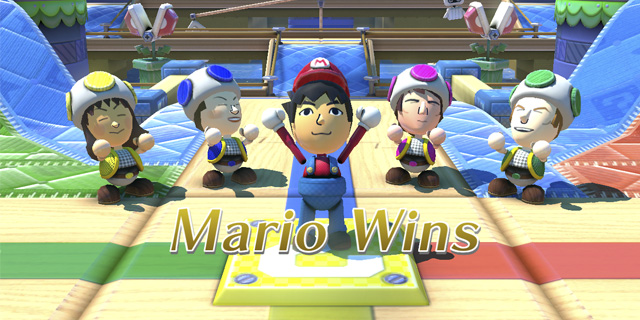
The Wii had Wii Sports, and it was meant to show off the fact that Nintendo believes anyone can be a gamer. It succeeded in that goal, propelling the Wii into the record books. Now, with Nintendo tasked with finding a way to replicate that success, they’ve turned to Nintendo Land to do so. Just like Wii Sports, the goal here is to showcase the ability of the GamePad to provide new ways of playing games. And it results in a rather interesting collection of games, that all add up to a solid party title.
Luigi’s Ghost Mansion: Luigi’s Ghost Mansion might be the best single multiplayer game in the entire package. It’s a game of hide-and-seek, but the hider is invisible and only able to be seen when exposed by flashlights. Up to four players on Wii Remotes are searching for a ghost in a mansion, with three different layouts to play in. Each player has a flashlight, and they have to coordinate their efforts to expose the ghost long enough to beat it. Their remotes will vibrate when in proximity to the ghost, though no directional indicators are given. The ghost’s goal is to sneak up on and attack each of the other players. Just like hide and seek, this is a ton of fun for both the ghost and those who are seeking it. – Shawn Vermette
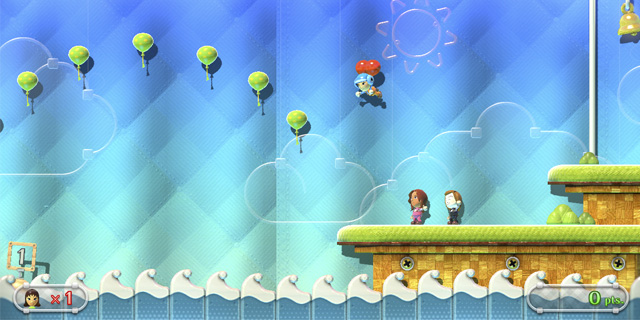
Balloon Trip Breeze: A throwback to the original Balloon Fight on the NES, Balloon Trip Breeze is a minigame that’s all about using the touch screen to move your little Mii from one end of the screen to the other. Along the way, you collect balloons, defeat enemies and avoid obstacles. This is probably the best single-player game in Nintendo Land, mostly due to its simplistic nature and great level design. The first session can be finished in less than fifteen minutes, but once you get through it the first time it becomes longer and more difficult on subsequent attempts. This is an addictive addition to Nintendo Land that showcases the Wii U’s best features, while also being just an enjoyable game that anyone can pick up and play. – Andrew Passafiume
Metroid Blast: This is the most core-friendly game on the disc. How do I know? The game tells you it is. Metroid Blast has you suit up like Samus and shoot enemies and friends in various modes. The competitive play is where it’s best, be it free-for-all or four Samus players against the GamePad’s spaceship. The cooperative missions are hit-or-miss, relying on inconsistent waves and strange collection mechanics, but they’re still… serviceable. – Graham Russell
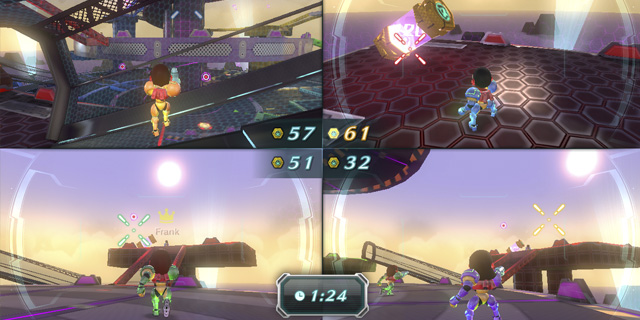
Octopus Dance: Octopus Dance is a rhythm game that is centered around copying dance moves using the GamePad. The TV will show your character facing you, while the GamePad shows them from the rear. The other character will perform a set of movements that involve controlling your Mii’s arms with the analog sticks, and shaking the controller to jump. The controls are basic, and the available songs aren’t really that memorable. While I wasn’t expecting Dance Central or Rock Band, having some Nintendo game tracks would have been nice. I also found going between the front and back views led to confusion between left and right, due to the TV view being mirrored, where the sticks are opposite from what is showing on the screen. It was also a bit awkward, as the character you are following is sometimes partially off one side of the GamePad screen. – Jeff DeSolla
The Legend of Zelda: Battle Quest: This is a rather interesting minigame because what you get out of it will vary greatly based on whether you are the GamePad player or a Wii Remote player. When using the remote, you’re a self-propelled swordsman in the vein of Wii Sports Resort. The gameplay here isn’t deep, but it is enjoyable with friends. The GamePad player, however, is an archer, using the gyroscope and left stick to aim and the right stick to shoot. You’ll go through progressively more difficult courses, each relying more and more on the archer. This game is best experienced with a group of friends switching off as the archer. – Shawn Vermette
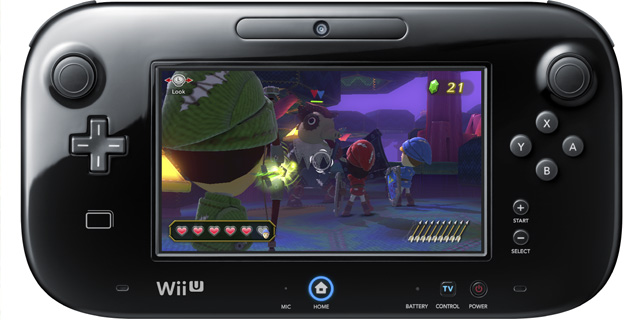
Donkey Kong’s Crash Course: Crash Course is a 2D action game that makes use of the GamePad’s tilt functions to guide a car (with a picture of your Mii on it) through a series of obstacles and traps. The physics remind me a bit of LittleBigPlanet, though it occurs on a single 2D plane. The game shows some Donkey Kong-style features, such as barrels, bananas, and a princess at the goal. It really doesnt show much of DK or the rest of the Kong clan, unfortunately. The gameplay is simple, with left and right tilt controlling the movement, which works much like the Vita’s tilt, though feels a bit smoother, due to the hardware being larger. The player has a set number of lives to complete the course, and restarts from the nearest checkpoint if they fail. Crashing, getting hung up on geometry, and simply hitting an object while going too fast will cause you to explode and lose a life, though pushing Y will return to the previous checkpoint with no penalty. The game is fun and addictive, though feels more like a mobile game than anything else. It shows off that the GamePad can tilt, but not much else. – Jeff DeSolla
Mario Chase: This one’s arguably the least reminiscent of the attached franchise out of all of Nintendo Land’s games, but it doesn’t matter: it’s a heck of a lot of fun. A team of Toads with limited third-person cameras tries to catch the GamePad player (“Mario”) in an arena within a given time limit. They’re given a radar that tells them how far away Mario is, so it’s communication between them that makes the search fun and effective. The game’s probably a bit balanced toward the Toads at this point, but even when Mario loses, sticking it out a little longer than last time is just as rewarding. – Graham Russell
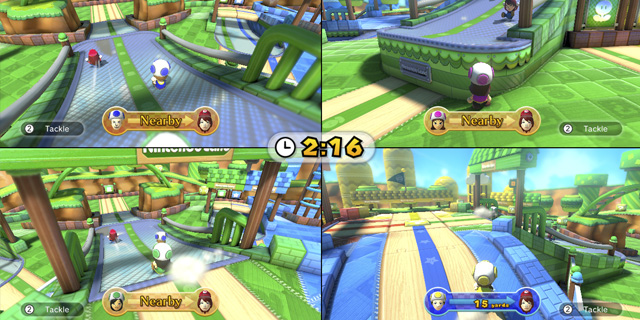
Captain Falcon’s Twister Race: Lacking the speed, challenge or anything that makes the F-Zero franchise so memorable, Captain Falcon’s Twister Race is a huge mess. You turn the Wii U controller on its side and twist it to turn as you drive along lengthy, sometimes dangerous tracks. There is no real sense of speed, and the basic concept, while interesting, is flawed. It works, but it lacks any real gameplay hooks and can range from tedious to frustrating in a matter of seconds. Once you finish a course, there is no real reason to replay them unless you are absolutely dead set on beating an old time, which I doubt very many people will find reason to do. There is room to expand this potentially-fun idea in a sequel, but there is nothing compelling about it as it stands. – Andrew Passafiume
Animal Crossing: Sweet Days: Sweet Days is similar to Mario Chase, except that the GamePad player is the chaser, and the other players are trying to collect a set amount of candy before they are caught too many times. The catch is that the chaser controls two people, one with each stick, and that the players collecting candy get slower with each piece of candy they collect. It’s a nice twist, and one that requires definite ambidextrous ability to be very good at chasing. It won’t last too long, like most of the other games, and it best when playing in a party setting and rotating each player through. – Shawn Vermette
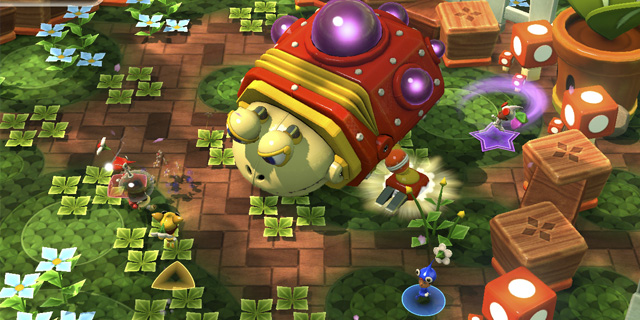
Takamaru’s Ninja Castle: Based on a NES game that many of us are unfamiliar with, Takamaru’s Ninja Castle works as a shooting gallery or rail shooter, with the player launching throwing stars by holding the gamepad flat in front of them, and sliding forward to throw a star. Enemies will appear, and sometimes throw stars or bombs back at you, each of which can be hit with your own stars to deflect them. Other enemies may jump up in your face with swords, hit them quickly to defeat them. The sensor bar will detect the gamepad, and let you aim your throwing stars by moving the GamePad. If it loses sync, or you need to reload stars, the rail shooter standard of aiming outside of the screen will do this. Holding the GamePad flat can be somewhat awkward at first. Otherwise, this is a great example of a minigame showing off some of the less expected uses of the system. I did not expect to be able to aim with the GamePad in this position, though after a while it becomes second nature. – Jeff DeSolla
Pikmin Adventure: Nominally a Pikmin game, Pikmin Adventure doesn’t really share much with its inspiration. The GamePad player is Olimar and sends out Pikmin using the touch screen, and other players are larger, more powerful Pikmin. You’ll basically run around, destroy blocks and all swarm the most powerful enemy on the screen when it pops up. Olimar can “gather” everyone and throw them, which is attempted as a cooperative mechanic, but in our experience it just makes people mad to lose control for a few seconds. Still, it’s visually very nice. – Graham Russell
Yoshi’s Fruit Cart: Following the same principle as Balloon Trip Breeze, Yoshi’s Fruit Cart is a decently enjoyable game that is fun in very, very short bursts. Controlling a Yoshi robot (or something similar), you draw lines on the touch screen in order to guide it along a certain path. The goal of each level is to collect all of the fruit and reach the finish before your mechanical Yoshi runs out of power. You can only see the fruit on the television, making your job basically a lot of guess work, but it can be fun. There are some new obstacles thrown into the mix as you get farther along, but the core idea never really evolves and you’re left with a game that will get old before you even find yourself past the ten minute mark. It definitely has its charm, which does make up for the lack of anything substantial beyond the basic premise, but I doubt many people will return to this one after the first attempt. – Andrew Passafiume
An additional gameplay mode called the Attraction Tour, wherein up to five players can compete in three to 12 rounds of matches in any of the 12 games. Players take turns using the GamePad to choose from a selection of games and opponents and whoever wins gets points. If you aren’t involved in the actual game during a round, you choose who you think will win that round. If you’re correct, you get two points. Sporadically, bonus points can be earned and you can even swap scores, if you’re lucky. All in all, this is a great way to get plenty of variety and party gaming going, and the best way to play Nintendo Land.
Nintendo Land does what it sets out to do: showcase the GamePad. There are a few stinkers among the games, but even they are a lot of fun when the competition and party starts on the Attraction Tour. If you’re looking for a way to take advantage of the multiplayer potential of the Wii U, this will be right up your alley. If not, there are better options for you in the launch lineup.
Pros: Great use of the GamePad for different game experiences, Attraction Tour mode makes the entire experience a blast
Cons: Some games are too simplistic or just uninteresting



















